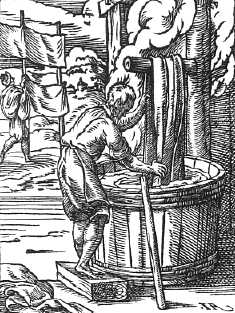The dyer
Like brewing and weaving, dyeing had recently been a cottage industry under the supervision of women, but was becoming increasingly a profession for men. Here is a recipe for a housewife still interested in dyeing cloth:
To dye wool black
First then to dye wool black, you shall take two pound of galls*, and bruise them, then take half so much of the best green copperas, and boil them both together in two gallons of running water; then shall you put your wool therein and boil it; so done, take it forth and dry it.
From Gervase Markham, The English Housewife (1615).
Footnotes
-
Galls
"Oak apples," or galls, are the protuberances on oaks caused by insect parasites. Galls are particularly rich in tannin, which reacts with iron (copperas is iron sulphate) to form ink.
